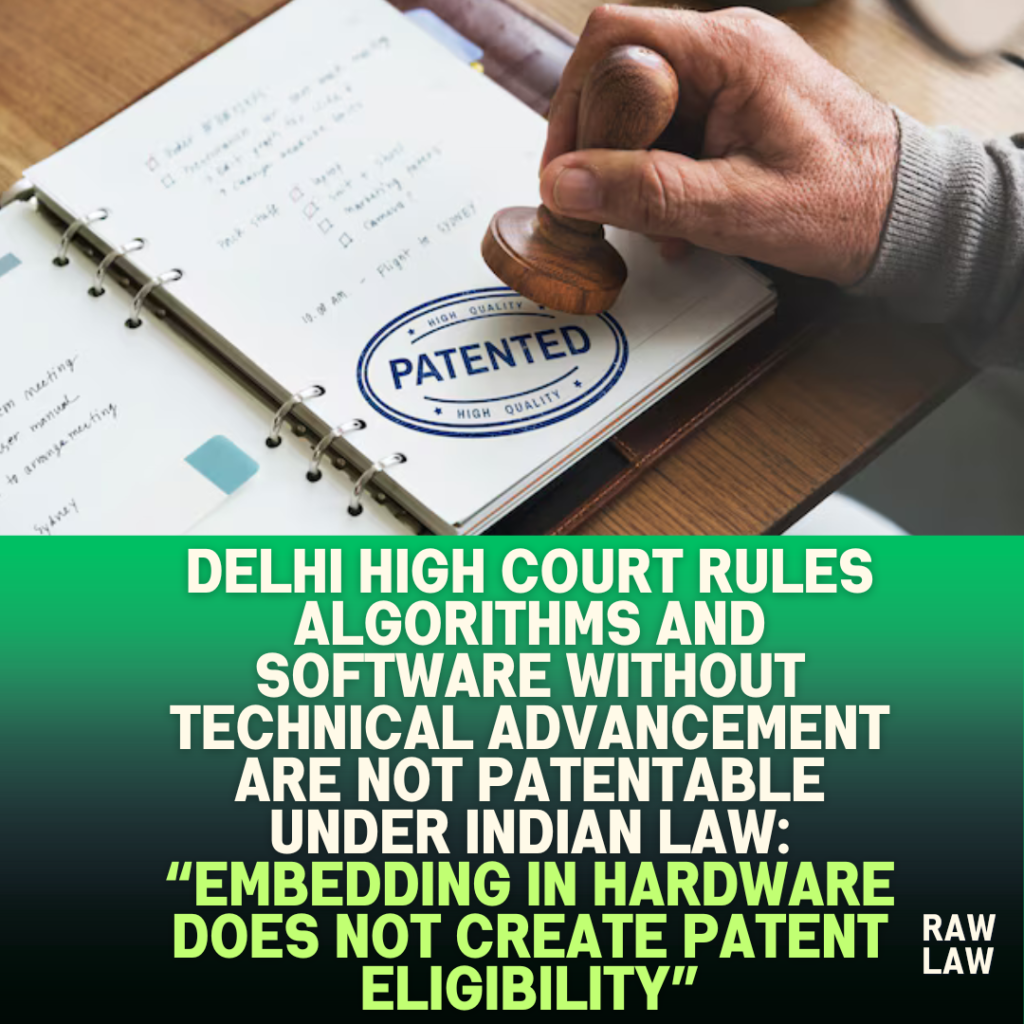Court’s Decision
The Delhi High Court dismissed Kroll Information Assurance LLC’s appeal challenging the Controller’s refusal of its patent application for a system and method to locate persons via peer-to-peer networks. The Court held that the claimed invention, though embedded in hardware, did not demonstrate any technical advancement or transform the hardware’s functionality, and thus, fell under the exclusion of “computer programme per se” and “algorithm” under Section 3(k) of the Patents Act, 1970.
The Court, however, held that the Controller’s rejection of proposed claim amendments under Section 59 was erroneous, as these amendments narrowed the claims without expanding their scope, thus were legally permissible. Despite this, the appeal was dismissed due to the overarching bar under Section 3(k).
Facts
Kroll Information Assurance, a US-based entity, filed a national phase patent application in India for a system to locate persons using peer-to-peer networks, claiming priority from a US application dated 12 April 2005. The application was initially filed on 19 October 2007, examined in 2013, and heard in 2019. The Controller refused the application citing:
- Amendments beyond the original claim scope (Section 59).
- Lack of inventive step (Section 2(1)(j)).
- Falling under non-patentable subject matter as “algorithm”/“computer programme per se” (Section 3(k)).
Kroll argued that its invention aimed to identify sensitive information being inadvertently shared on peer-to-peer networks, aiding in security management and demonstrating a technical effect when implemented via hardware.
Issues
- Whether the proposed amendments to the claims were impermissible under Section 59 of the Act.
- Whether the invention fell under “computer programme per se” or “algorithm” excluded under Section 3(k) of the Act.
- Whether the invention lacked an inventive step under Section 2(1)(j).
Petitioner’s Arguments
Kroll argued that:
- The proposed claim amendments were within scope and narrowed the claims, serving as clarifications and thus permissible under Section 59.
- The invention provided a technical effect by identifying and preventing unauthorized data sharing on peer-to-peer networks, combining hardware and software to enhance security infrastructure.
- Prior art (D1) cited was based on a client-server model, whereas the invention targeted peer-to-peer environments with profiling, thereby demonstrating novelty and inventive step.
- The invention was granted patents in the USA, China, Australia, and Japan, indicating its inventive merits.
Respondent’s Arguments
The Controller argued that:
- The amendments introduced features not disclosed in the original claims, expanding scope, and violating Section 59.
- The claimed invention was essentially a computer-implemented algorithm for query processing on a peer-to-peer network, lacking any technical effect or hardware transformation.
- Searching peer-to-peer networks was routine and obvious, rendering the invention non-inventive.
- The claims fell squarely under exclusions provided in Section 3(k) for “computer programme per se” and “algorithm”.
Analysis of the Law
The Court examined:
- Section 59: Referring to Nippon A & L Inc. v. Controller of Patents, the Court held amendments must be by disclaimer, correction, or explanation without expanding claim scope.
- Section 3(k): Applying Lava International, Microsoft Technology Licensing, and Blackberry v. Controller, the Court emphasized that algorithms and computer programmes without demonstrable technical effect or hardware transformation are non-patentable.
- CRI Guidelines, 2017: Reinforced that claims must show technical advancement and a practical application enhancing hardware functionality to escape Section 3(k).
Precedent Analysis
- Nippon A & L Inc. v. Controller of Patents (2022 SCC OnLine Del 1909): Clarified conditions under Section 59 for permissible amendments.
- Lava International Ltd. v. Telefonaktiebolaget LM Ericsson (2024 SCC OnLine Del 2497): Established that software patents require technical enhancement of hardware to qualify.
- Microsoft Technology Licensing v. Controller of Patents (2024 SCC OnLine Del 3239): Reiterated that software-related inventions must demonstrate tangible technical effects beyond general computing.
- Blackberry v. Controller of Patents & Designs: Confirmed algorithms without hardware enhancement are not patentable under Section 3(k).
Court’s Reasoning
- The Court accepted that Kroll’s amendments narrowed the claims and were thus permissible under Section 59.
- However, the Court held that the claimed invention, at its core, enabled keyword-based searching and profiling within a peer-to-peer network using conventional computing resources, reflecting standard “computer programme per se” behavior without technical advancement.
- The profiling mechanism, while useful for security monitoring, was abstract and did not transform or enhance hardware capabilities, thus falling under Section 3(k).
- Since the invention did not surpass the threshold required for software-related inventions under Indian patent law, it was not eligible for patent protection.
Conclusion
The Delhi High Court dismissed the appeal while clarifying that although the proposed amendments were permissible, the invention was excluded under Section 3(k) as it merely constituted an “algorithm” and “computer programme per se” without demonstrating any technical advancement to the hardware. The Controller’s refusal was upheld.
Implications
- Reinforces India’s strict stance on software patenting, requiring demonstrable technical advancements and hardware transformation for eligibility.
- Highlights the importance of establishing clear technical effects beyond abstract software functionalities in patent applications.
- Clarifies permissible scope of amendments under Section 59, supporting narrower clarifications if within original claim disclosure.
FAQs
1. Is software patentable in India under the Patents Act, 1970?
Software is not patentable “per se” unless it demonstrates a technical effect or hardware transformation beyond a mere algorithm, as reinforced in this judgment under Section 3(k).
2. Can amendments be made to patent claims after filing in India?
Yes, amendments are allowed under Section 59 only if they act as disclaimers, corrections, or explanations without expanding the claim scope, as clarified by the Court.
3. What was the key reason for the rejection of Kroll’s patent application?
The invention was held to be a mere algorithm/computer programme without technical advancement, failing the test under Section 3(k), despite the amendments being acceptable.



